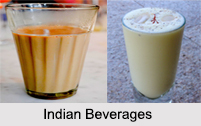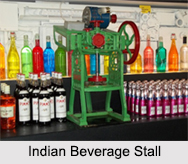 India has remained legendary, rising to top chart for its mouth-watering, refreshing, cheap and easy to make beverages. The beverages available in India have formulated the choicest selection of interesting drinks that are reflective of the indigenous culture. Beverages in India possess that "something special" about the drinking concoction or mix, which is mostly introduced and instilled in the drink. Any given beverage possesses an interrelation with the culture of a particular society. These drinks are popular on festive occasions and served for entertaining guests. Beverages are also served at Indian weddings, amidst much fanfare.
India has remained legendary, rising to top chart for its mouth-watering, refreshing, cheap and easy to make beverages. The beverages available in India have formulated the choicest selection of interesting drinks that are reflective of the indigenous culture. Beverages in India possess that "something special" about the drinking concoction or mix, which is mostly introduced and instilled in the drink. Any given beverage possesses an interrelation with the culture of a particular society. These drinks are popular on festive occasions and served for entertaining guests. Beverages are also served at Indian weddings, amidst much fanfare.
History of Indian Beverages
The Mughals are acknowledged to have introduced the concept of "Sharbat" which is a sweet fruit or flower fragrant beverages amongst the pan-Indian populace, moving finally from royal household. The British Raj were the foremost to introduce the class as well as the mass to get hooked on to "Tea" time, ensuing in the most legendary and admired Indian beverages recognised as "Garam Chai" or "Masala Chai".
Types of Indian Beverages
 India has a food culture that loves a beverage, before their meals, during their meals and also a beverage to end their meals. Indians also have beverages like a "Kesar Doodh" or a "Masala Doodh" or even a "Haldi Doodh" before bedtime. The most traditional Indian beverages comprise Garam-Chai, Lassi, Chaach, Sharbat, Thandai, Shikanji, Kanji or even sweetened milk with ground nuts. Jal-Jeera is a popular street beverage in the whole of the country.
India has a food culture that loves a beverage, before their meals, during their meals and also a beverage to end their meals. Indians also have beverages like a "Kesar Doodh" or a "Masala Doodh" or even a "Haldi Doodh" before bedtime. The most traditional Indian beverages comprise Garam-Chai, Lassi, Chaach, Sharbat, Thandai, Shikanji, Kanji or even sweetened milk with ground nuts. Jal-Jeera is a popular street beverage in the whole of the country.
Tea and coffee are indeed most common beverages in India. Liked in both the hot and cold variations, they are served in umpteen varieties all across India. Another popular beverage, Coffee, is largely dished out in South India. One of the finest varieties of Coffee is grown in stretches of Mysore, Karnataka, and is marketed under the trade name "Mysore Nuggets".
Other beverages incorporate Nimbu Pani, Lassi, Chaach, Badam Doodh, Sharbat and Coconut water. Although the above listed Indian beverages are popular, the populace prefers to consume drinking water with their food, because water does not ever outshine the smack of the food. In fact, it is customary to offer drinking water to guests in any Indian household before serving any hot or cold drinks.
Whether to beat the heat of oppressive Indian summer or just to savour the taste, Indian beverages do possess a worldwide appeal. Tasty, refreshing, easy to make and at the same time cheap, Indian beverages have efficiently carried off a number of celebrations.




















